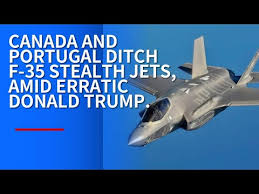My Article published on the EurasianTimes Website on 19 Mar 25.
In an interesting development, Portugal, Canada, and Germany are hesitating over the F-35. These developments can be both a challenge and an opportunity for India, whether India should jump into the fray and take the risk or stay away.
Indian Worries. India’s worries include operational and maintenance challenges, US policy uncertainty and technology transfer issues. Countries reconsidering their F-35 purchases usually cite concerns about high operational costs, maintenance complexities, and reliability issues. If a country like Canada, with a strong NATO supply chain, has problems, India, without an established F-35 ecosystem, could face serious logistics nightmares. India has historically struggled with restrictive American defence deals (e.g., CAATSA concerns with Russia). If Canada and Portugal are reconsidering under U.S. influence, India’s potential F-35 deal might come with diplomatic strings attached. Moreover, the U.S. is unlikely to share deep tech integration rights.
Opportunity. On the bright side, the cancellations by these countries could open up production slots, potentially leading to expedited deliveries if India proceeds with an F-35 deal. Furthermore, under these circumstances, Lockheed Martin may be more accommodating in pricing or support agreements with India. A limited number of F-35s could act as a stepping stone to India’s indigenous AMCA program, providing valuable 5th-gen combat experience until India develops its own.
Balancing Affordability and Capability. Balancing affordability and capability in fighter acquisition programs is a complex and intellectually stimulating challenge in defence procurement. Modern fighter jets, with their advanced avionics, stealth technology, and weapons systems, are not just engineering marvels but also strategic assets that can dominate air, land, and sea. However, these capabilities come at a steep cost, and governments must grapple with budgetary constraints while ensuring their air forces remain capable of addressing current and future threats.
Trade-offs. Understanding and navigating the myriad trade-offs in fighter aircraft acquisition programs are a cornerstone of defence procurement. Balancing performance, cost, operational requirements, and strategic objectives is a complex task that governments and military planners must master to ensure optimal capability within the constraints of their resources. This knowledge empowers decision-makers and enhances the effectiveness of defence strategies.
Trade-Offs for Consideration in Fighter Acquisition Programs
Cost vs. Capability. A fundamental trade-off in fighter acquisition is between cost and capability. High-end fifth-generation fighters like the F-35 and the F-22 offer unparalleled performance but come at an exorbitant price. More cost-effective alternatives, such as the F-16 or the Gripen, may lack some advanced features but remain viable options for many air forces. Nations must decide whether to prioritise cutting-edge technology or opt for a more extensive fleet with slightly reduced capabilities.
Multirole Flexibility vs. Specialisation. Many modern fighters, such as the F-35 and Rafale, are designed as multirole platforms capable of performing air-to-air, air-to-ground, and electronic warfare missions. This flexibility reduces fleet diversity but may lead to compromises in specific roles. In contrast, specialised aircraft like the A-10 Thunderbolt II excel in close air support but lack air superiority capabilities. Decision-makers must weigh whether a single multirole platform meets their needs or if specialised aircraft are necessary.
Short-Term vs. Long-Term Investment. Some nations prioritise acquiring proven, off-the-shelf platforms that provide immediate operational capability, while others invest in the long-term development of next-generation aircraft. The former minimises short-term risks but may become outdated sooner. The latter approach, seen in programs like the Tempest and NGAD, is high-risk but ensures future technological superiority.
Fleet Size vs. High-End Technology. Budget constraints often force militaries to choose between a more extensive fleet of less advanced fighters or a smaller number of top-tier aircraft. A more comprehensive fleet provides more coverage and sortie rates, while a smaller fleet of high-end fighters offers superior combat capability. For instance, many nations supplement their fleets of expensive stealth aircraft with cheaper fourth-generation fighters to maintain numbers.
Capability vs. Quantity. Nations must decide between procuring fewer advanced jets or a more extensive fleet of less capable aircraft. For instance, the U.S. chose to supplement its high-end F-22 fleet with the more affordable F-35, while countries like China and Russia have emphasised quantity to ensure strategic depth.
Indigenous Development vs. Foreign Procurement. Countries face a strategic choice between developing domestic fighter programs and purchasing from foreign suppliers. Indigenous programs, such as India’s Tejas/AMCA or South Korea’s KF-21, promote self-sufficiency but require significant research and industrial infrastructure investment. Buying foreign jets ensures immediate capability but can lead to dependency on external suppliers.
Indigenous Fighter Development for Cost-Effectiveness. India’s HAL Tejas was developed to reduce reliance on foreign fighters while maintaining affordability. Designed with modular upgrades in mind, the Tejas has gradually improved with better radar, weapons integration, and avionics. Despite delays in development, its affordability compared to Western counterparts has made it an attractive option for India’s long-term air power strategy.
Balancing Affordability and Capability
Balancing affordability and capability in fighter acquisition programs is a complex but essential task for modern air forces. Governments must ensure that their aircraft provide operational effectiveness without exceeding budgetary constraints. The following best practices help achieve this balance.
Comprehensive Lifecycle Planning. A fighter jet’s cost extends far beyond its initial acquisition price. Governments must consider long-term expenses, including operation, maintenance, upgrades, and eventual disposal. Comprehensive lifecycle cost analysis, which involves estimating all costs associated with a system over its entire life, helps mitigate budgetary surprises and ensures financial sustainability over decades of service.
Incremental Upgrades. Modern fighter jets should have modular systems and open architectures to accommodate incremental upgrades. This approach extends an aircraft’s service life while spreading costs over time. The F-16 Fighting Falcon, introduced in the 1970s, remains operational due to continuous upgrades in avionics, radar, and weapons. This strategy prevents obsolescence while reducing the need for costly new aircraft acquisitions.
Focus on Multi-Role Capability. Multi-role fighters provide greater operational flexibility by performing various missions with a single platform. The Dassault Rafale exemplifies this concept, capable of air-to-air combat, ground attack, and reconnaissance missions. This versatility allows air forces to reduce the number of specialised aircraft types, simplifying logistics and maintenance while lowering overall costs.
Prioritising Export Potential. Designing fighter jets with exportability in mind helps amortise development costs and reduce per-unit expenses. Countries that successfully market their fighters to foreign buyers can reinvest revenues into further technological advancements.
Emerging Trends and Technologies. Technological advancements are reshaping how air forces balance affordability and capability. The following emerging trends offer cost-effective solutions while enhancing combat effectiveness.
Unmanned Systems. Unmanned aerial vehicles (UAVs) and ‘loyal wingman’ drones, which are autonomous aircraft that operate alongside manned aircraft, complement traditional fighter jets by taking on high-risk missions at a lower cost. These platforms can conduct reconnaissance, electronic warfare, and combat operations without endangering pilots. Programs like the Boeing MQ-28 Ghost Bat highlight the growing role of UAVs and ‘loyal wingman’ drones in modern air combat.
Artificial Intelligence. AI-powered systems improve decision-making, enhance situational awareness, and reduce pilot workload. Advanced AI integration enables autonomous operations, making fighters more effective while potentially reducing crew training costs. AI-driven mission planning and adaptive combat algorithms are key to next-generation fighter capabilities.
Conclusion
Balancing affordability and capability in fighter acquisition programs is a complex but essential endeavour. As nations face evolving threats and fiscal constraints, the ability to make strategic trade-offs will determine their air power’s effectiveness. By embracing innovative technologies and fostering international collaboration, governments can achieve an optimal balance that ensures operational readiness and financial sustainability.
India traditionally prefers non-restrictive platforms like the Rafale and Su-30MKI that allow customisation. The F-35, despite its advanced stealth and networking, is deeply tied to U.S. control mechanisms. If Germany, Canada, and Portugal, NATO allies with solid U.S. interoperability, are hesitating, India must be doubly cautious before signing anything. The Big Question, however, remains whether India should even consider the F-35. After analysing the factors mentioned earlier, the current answer is negative (even with faster delivery schedules).
For considering the F-35 as a potential option for India, several critical concerns must be addressed to make it a viable choice. Foremost among these is the issue of technology transfer and support to Indigenous aircraft development. Operational sovereignty is essential, as any restrictions imposed by the U.S. could limit India’s ability to integrate indigenous systems and conduct independent upgrades. Cost considerations (including procurement, maintenance, and lifecycle expenses) must be carefully weighed against alternative platforms. Geopolitical reliability is another key factor, given past U.S. sanctions and export restrictions that could impact fleet sustainability. Finally, interoperability with India’s existing fleet and infrastructure must be thoroughly assessed to ensure seamless integration without excessive logistical burdens. Addressing these concerns through ironclad agreements and long-term strategic assurances would be essential for India even to consider the F-35 option (in limited numbers).
Please Do Comment.
Link to the article on the website:-
U.S.-China Tensions: F-16 Vipers To Get LRASM Capability That Could Puncture World’s Biggest Navy
For regular updates, please register your email here:-
References and credits
To all the online sites and channels.
Pics Courtesy: Internet
Disclaimer:
Information and data included in the blog are for educational & non-commercial purposes only and have been carefully adapted, excerpted, or edited from reliable and accurate sources. All copyrighted material belongs to respective owners and is provided only for wider dissemination.



